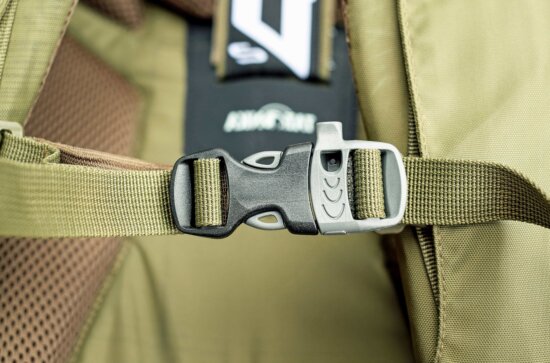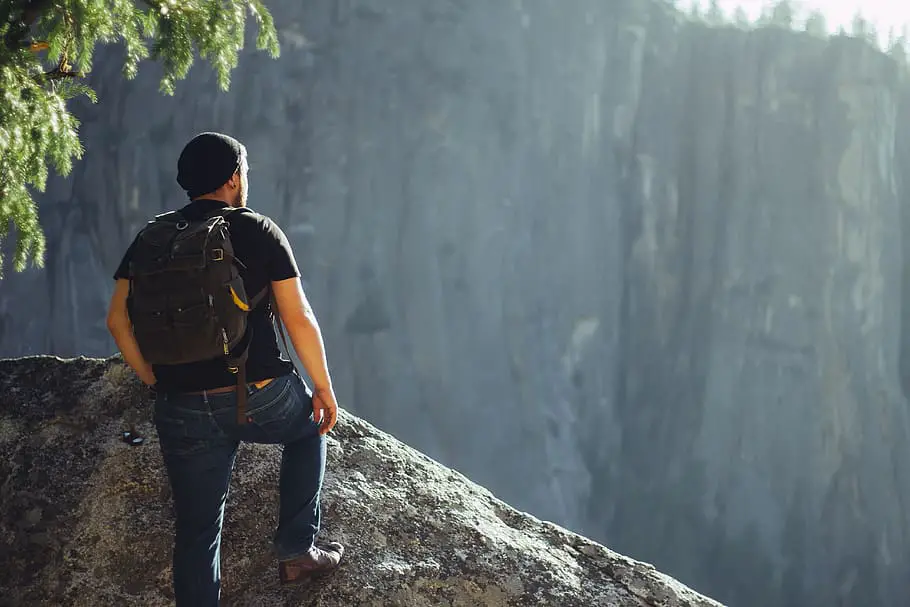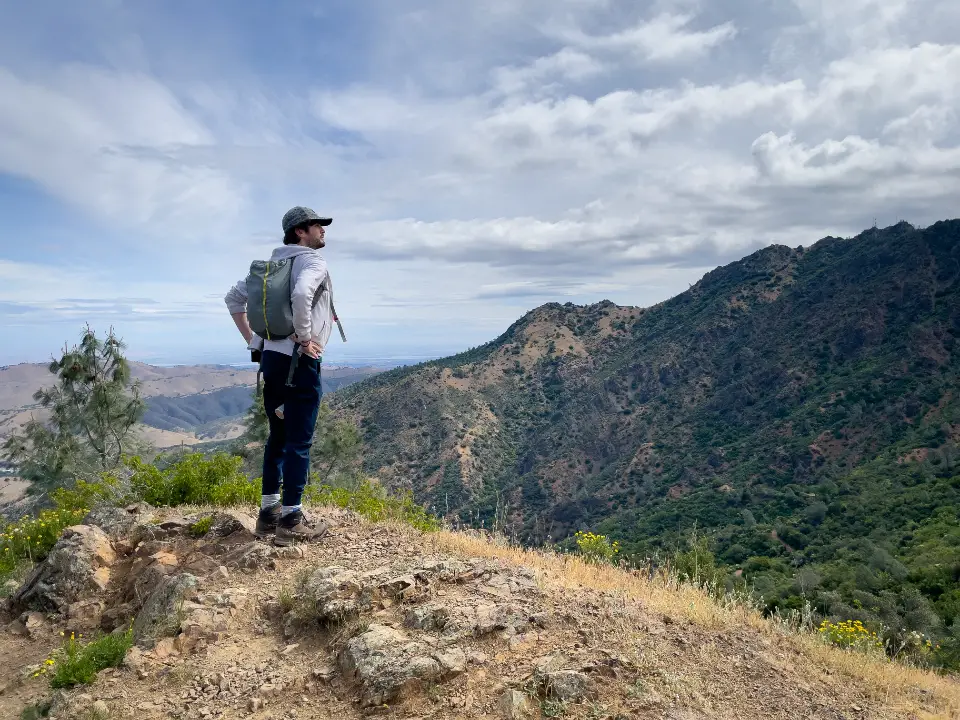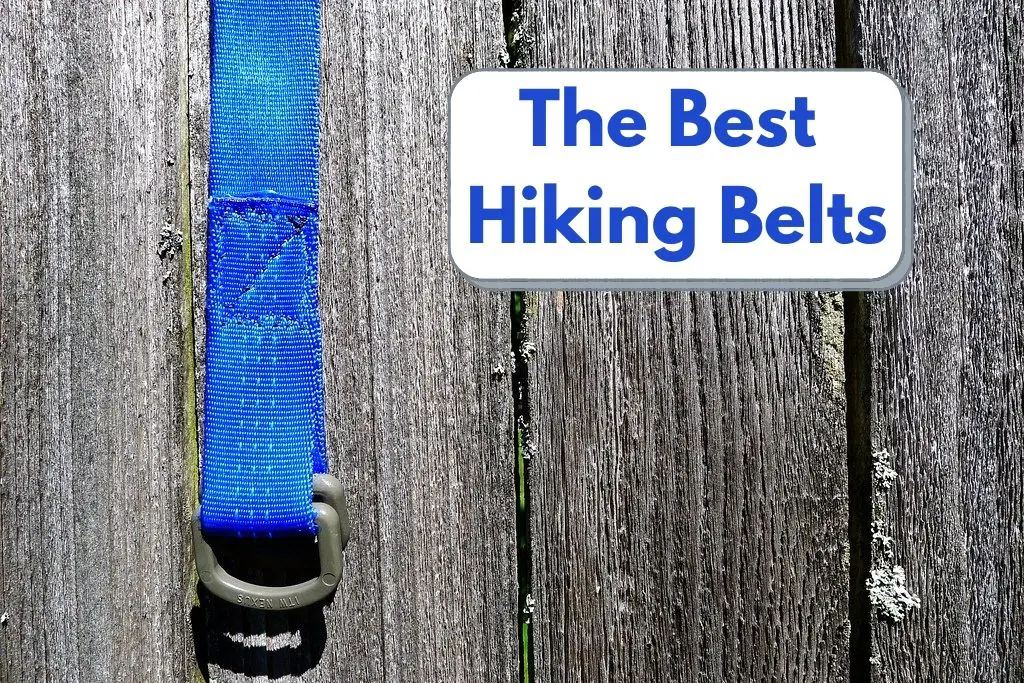A proper hiking belt is an often overlooked but essential piece of gear in any hiker’s setup.
At first glance, a hiking belt seems like any other belt – it’s job is to keep your pants up!
There’s much more to it than that, and there are plenty of factors to consider when picking the best hiking belt for your needs.
That’s exactly why we put together this guide to the best reviewed hiking belts available.
The 8 Best Hiking Belts Available Today
| Best Overall Hiking Belt | Arcteryx Conveyor Belt |
| Best Versatile Hiking Belt | Bison Designs Tap Cap 38mm Belt |
| Best Elastic Hiking Belt | Arcade Midnighter Hiking Belt |
| Best Lightweight Hiking Belt | Thomas Bates Hiker Belt |
| Best Survival Hiking Belt | RattlerStrap Paracord Survival Hiking Belt |
| Best Polyester Hiking Belt | Under Armour Webbing Hiking Belt 2.0 |
| Most Affordable Hiking Belt | Columbia Military Web Hiking Belt |
Arcteryx Conveyor Belt

The Arcteryx Conveyor Belt topped our list due to it’s lightweight materials, high durability ratings, and nylon webbing construction paired with a sturdy metal buckle.
The performance factor is what set this thing off the charts, as it is great with keeping you secure no matter how heavy your load gets, even with soaking wet gear and pants.
Arcteryx is a highly-regarded brand in the areas of hikers, campers, and backpackers, and this belt is a shining example of their commitment to quality.
Why We Like It:
-Excellent support
-Nylon webbing is sturdy yet comfortable
-Well-known, well-trusted brand
Bison Designs Tap Cap 38mm Belt

The Bison Designs Tap Cap 38mm Belt is a sturdy nylon-constructed belt that includes a nice solid-gripping gunmetal buckle with strong teeth to ensure a hold that stays all day long through any conditions.
This belt is great-looking and comes in up to four, so there’s sure to be one that fits your style.
As an added bonus, there’s a bottle opener incorporated into the buckle. Win-win!
Why We Like It:
-Stylish and sturdy
–Can be cut to desired length
–Bottle opener is a nice touch
Arcade Midnighter Hiking Belt

The Arcade Midnighter Belt is made of slimmed-down elastic stretch webbing, helping it to conform to your exact waist size for a great fit and can hold up what you’re carrying for long periods of time.
The belt itself is only 1.25” wide, making it easy to fit into narrow belt loops, and it’s also made of quick-drying materials.
It has a metal-free buckle so you can wear it while going through TSA checkpoints, and is extremely compact and versatile.
Why We Like It:
-Stretch material conforms comfortably and adapts well
-Stylish, quick-drying, and compact
-Metal-free minimal design
Thomas Bates Hiker Belt

The Thomas Bates Hiker Belt is a USA-made, nylon adjustable buckle belt that comes in up to 7 different colors.
It has a metal-free design and can be cut to size, and the nylon is lightweight yet rigid, so it holds well.
This belt is also comfortable and breathable, making it a very popular choice for hikers, campers, bikers, and other outdoor enthusiasts.
Why We Like It:
-Lightweight yet rigid
-Can be cut to length and is metal-free
-Comes in up to 7 different colors
RattlerStrap Paracord Survival Hiking Belt

The RattlerStrap Paracord Survival Hiking Belt is all about being prepared, allowing you to carry over 80 feet of paracord with you wherever you go.
It features a titanium buckle that can stand up to nearly anything, and the paracord webbing design makes it infinitely adjustable and good for all kinds of weather.
The best part is RattlerStrap’s guarantee – if you ever need to actually use the paracord, just send them the buckle back and they’ll replace the entire belt!
Why We Like It:
-Lifetime guarantee is an awesome value
-Survival gear packed into a comfortable and secure hiking belt
-Made from durable and all-weather materials
Under Armour Webbing Hiking Belt 2.0

The Under Armour Webbing Belt 2.0 is a polyester belt featuring a clamp closure that’s also machine washable.
It’s durable webbed construction offers flexibility and is great for a wide variety of outdoor sports and activities – especially hiking.
It comes in up to 7 different colors, and is also reversible to a solid black color, giving you extra versatility, while it’s 1.4” width makes it small enough for narrower belt loops.
Why Like It:
-Reversible design
-Durable yet flexible
-Machine washable
Columbia Military Web Hiking Belt

The Columbia Military Web Belt is a solid performer from a well-known brand that’s trusted for excellent outdoor gear.
It’s canvas construction is reliable and versatile, and it’s 1.5” width allows it to pass through belt loops with ease.
The metal plaque buckle keeps your fit locked in all day but releases easily when you’re done.
Why Like It:
-Extremely affordable (under $15 at the time of publishing this article)
-Up to 7 different color options
-Stylish and very versatile
Fairwin Tactical Hiking Belt

The Fairwin Tactical Hiking Belt made our list due to a bunch of unique features that the other belts on this list didn’t offer.
It has a smooth quick-release function on the hardy buckle, and is constructed fully from nylon so it’s comfortable yet sturdy.
The nylon webbing is breathable and dries quickly, is offered in 6 different colors, and comes in sizes ranging from 30”-54” so nearly anyone can get a great-fitting belt.
Why Like It:
-Tough quick-release buckle
-Breathable and fast-drying
-Easily adjustable

Choosing The Best Hiking Belt – What Features To Look For
There’s a surprising amount of factors that go into choosing the best hiking belt for your situation, and each plays an important role.
We’ll explore these in-depth below.
Why Your Hiking Belt Material Matters
Different hiking belt materials have different properties and characteristics which can impact a variety of factors like durability, functionality, flexibility, and comfort.
This makes a hiking belt’s material a very important factor to keep in mind when making your selection.
Nylon Hiking Belts
Nylon is extremely light, strong, durable, and abrasion-resistant. Additionally, as a synthetic, it is generally much cheaper than leather.
Sometimes nylon can be blended with rubber, spandex, or elastodiene to form a stretch webbing belt.
This is also true of polyester, but nylon doesn’t require the same breaking-in period that polyester does, giving nylon a leg up.
Canvas Hiking Belts
Canvas is an affordable tough fabric and is machine-washable, making it a great choice for durability.
Unfortunately, canvas absorbs water at a much higher rate than other fabrics, making this a poor choice for folks who sweat a lot or who will be hiking in rainy or other wet conditions.
Polyester Hiking Belts
Polyester is another synthetic like nylon, and has primarily the same benefits: it’s cheap, more comfortable, quick-drying, flexible, and lightweight – all prime characteristics you’ll want in a hiking belt!
Leather Hiking Belts
Leather hiking belts have tons of ruggedness and durability, but they’re much heavier and take significantly longer to dry when they get wet, which is the main reason there are no leather belts that made our top picks for hiking belts in this guide.
Oxford Fabric Belts
Oxford fabric offers tons of flexibility, durability, and also repels water, making it a great fabric choice for hiking belts.
It’s also easy to clean – an extra plus!

Choose The Best Hiking Belt Buckle Style
Just like materials, there are several different styles of hiking belt buckles, and your needs and planned usage are going to help determine which is best for you.
Read on for more info on hiking belt buckle types.
Tongue Buckles
Tongue buckles are the most common type of belt closure, commonly seen on leather belts and most casual or dress belts.
A tongue buckle consists of a frame, bar, and prongs, and may feature up to two prongs (although most are single-pronged).
Tongue buckles simply aren’t the best choice for hiking belts because they lack the flexibility and durability that you’ll want while on the trail.
Quick Release Buckles
Quick release buckles are focused on safety, and as such, are commonly found in military and tactical belts.
As their name implies, they offer a quick release by pressing two tabs on the top and bottom of the buckle.
Clamp Closure Buckles
In a clamp closure, there are two parts attached to a belt (think kind of like the old school car seat belts): one is larger, and the other is smaller, and they latch to each other to secure the belt together.
Flip Closure Buckles
A flip closure buckle employs teeth at the underside of the buckle to grip the fabric when you flip the buckle closed, so it doesn’t need any holes.
This buckle type is commonly found in canvas and fabric belts, and while easy to use, it can be more susceptible to slipping or wear and tear to the belt or the buckle itself over time.
Webbing Buckles
A webbing buckle employs friction and resistance to keep the belt tight, and although is convenient for resizing, it’s not the best at keeping it’s hold.
Buckle Material
Metal Buckles
Metal buckles are usually made from stainless steel, titanium, and aluminum, and are very durable.
One small trade-off of metal buckles is that they are heavier, and also need to be removed when going through metal detectors (such as TSA checkpoints).
Plastic Buckles
Plastic and non-metal buckles are becoming more popular among hikers and other outdoor enthusiasts, and they’re lighter than metal buckles.
An obvious drawback is that they lack durability compared to metal buckles, but are also significantly less expensive, so you can feel comfortable taking a chance on a plastic buckle.
Weight
The weight of your belt may seem insignificant, but every ounce matters and that fact is only compounded on longer hikes.
A tactical or leather belt will be much heavier than a elastic nylon belt, so pay attention to your needs and the other weight of your gear when choosing a hiking belt.
Length
Most hiking belts can be trimmed to length, but some cannot. Be sure to check the options available on your selected belt, and if it can’t be trimmed, select a belt that’s about 2” longer than your waist.
Width
The width of a hiking belt is an often overlooked detail, but it matters!
Generally speaking, a wider belt will fit into less pants and shorts loops, lessening it’s utility.
However, wider belt loops can be a little more comfortable than narrower belts, so pay attention to the loop sizes on most of your pants and shorts before making your hiking belt selection.
Durability
Hiking belts need to be durable no matter the intensity or duration of the hike, but obviously you’ll need a really rugged belt if backpacking for a week as compared to a 3 mile hike in your local park.
Attachment Options
Some hiking belts offer attachment points for things like holsters, carabiners, or other gear.
Consider your intended use and planned activities to determine if attachments will be of use to you.

Hiking Belt FAQs
A hiking belt is just like any other belt, but it’s emphasis lies on lightweight and breathable materials and the ability to keep its hold for long periods of time and lots of movement.
This is the reason that a nylon belt with a clasp closure would be much more suitable than a leather dress belt for hiking.
If you’re only going on a few hikes each year and they’re very simple short hikes, you probably don’t need a hiking belt.
Alternatively, if you spend plenty of time on the trail then you’re going to get plenty of use and enjoyment out of a proper belt made for hiking.
Don’t forget that hiking belts can also be worn as regular belts anyway and are very affordable!
Most hiking belts are thinner than other belts because they put a priority on being lightweight and breathable, which reduces overall padding.
Having said that, padding is not very important on a hiking belt, as the main concern is holding your pants up throughout extended hikes and movement.
Most manufacturers will advise you on if your hiking belt can be shortened and which method you can use.
This typically involves just cutting your hiking belt to length.
The best thing you can do if your belt is too short is to simply purchase another belt that’s the proper length for your waist.
Although there are belt extenders available, we don’t recommend them.
Wrapping Up The Best Hiking Belts
Hopefully this helped expand upon the importance and utility a proper hiking belt can bring to your gear setup.
For other great guides on gear, check out our reviews of the best neoprene socks for hiking, the best compression socks for hiking, the best minimalist hiking shoes, and our guide on the best hiking knives while you’re here.

